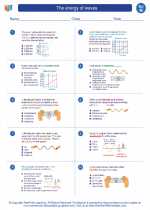Terrestrial Ecosystems
A terrestrial ecosystem is a type of ecosystem found on land. It is characterized by the presence of various living organisms and their interactions with the physical environment. These ecosystems can be found in diverse habitats such as forests, grasslands, deserts, and tundras.
Key Components of Terrestrial Ecosystems
- Abiotic Factors: These are non-living components of the ecosystem, including soil, water, air, temperature, and sunlight.
- Biotic Factors: These are living organisms within the ecosystem, including plants, animals, fungi, and microorganisms.
- Producers: Plants and other photosynthetic organisms that produce their own food through photosynthesis.
- Consumers: Organisms that obtain energy by consuming other organisms.
- Decomposers: Organisms that break down dead organic matter and release nutrients back into the ecosystem.
Types of Terrestrial Ecosystems
There are several types of terrestrial ecosystems, each with unique characteristics and biodiversity:
- Forest Ecosystems: These ecosystems are dominated by trees and are found in diverse regions such as tropical rainforests, temperate forests, and boreal forests.
- Grassland Ecosystems: These ecosystems are characterized by vast expanses of grasses and are found in regions with moderate rainfall.
- Desert Ecosystems: These ecosystems have low precipitation and are inhabited by specially adapted plants and animals that can survive in arid conditions.
- Tundra Ecosystems: These ecosystems are found in cold, treeless regions and are characterized by permafrost and low-growing vegetation.
Ecological Interactions in Terrestrial Ecosystems
Various ecological interactions occur within terrestrial ecosystems, including:
- Competition: Organisms compete for resources such as food, water, and territory.
- Predation: Predators hunt and consume prey, influencing population dynamics within the ecosystem.
- Symbiosis: Mutualistic, commensal, and parasitic relationships exist between different species, impacting their survival and reproduction.
- Succession: Ecosystems undergo changes over time through processes such as primary and secondary succession, leading to shifts in species composition.
Human Impact on Terrestrial Ecosystems
Human activities such as deforestation, urbanization, pollution, and climate change have significant impacts on terrestrial ecosystems, leading to habitat destruction, loss of biodiversity, and disruption of ecological balance.
Study Tips
To effectively study terrestrial ecosystems, consider the following tips:
- Understand the key components and interactions within terrestrial ecosystems.
- Learn about the characteristics and adaptations of different types of terrestrial ecosystems.
- Explore case studies and examples of human impact on terrestrial ecosystems.
- Engage in hands-on activities such as field observations, experiments, and ecological simulations.
- Review and practice with diagrams, flowcharts, and concept maps to visualize ecosystem dynamics.






